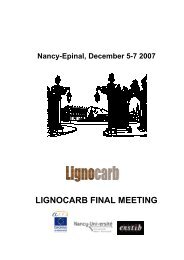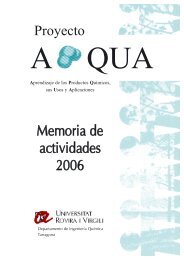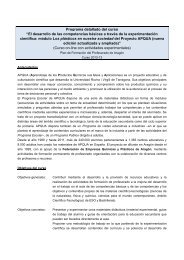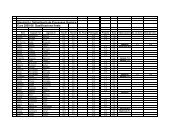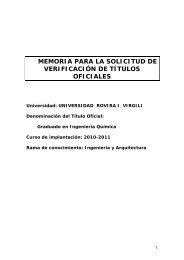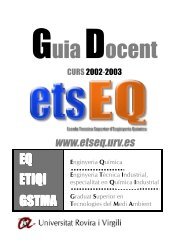A Transferable Force Field To Predict Phase Equilibria and Surface ...
A Transferable Force Field To Predict Phase Equilibria and Surface ...
A Transferable Force Field To Predict Phase Equilibria and Surface ...
Create successful ePaper yourself
Turn your PDF publications into a flip-book with our unique Google optimized e-Paper software.
The Journal of Physical Chemistry B ARTICLE<br />
energy corresponds to the missing torsion potential, <strong>and</strong> it is<br />
fitted according to eq 7. Finally, the O ether—CH 2—CH 2—O ether<br />
torsion encountered in 1,2-dimethoxyethane is determined from<br />
quantum calculations in the same manner. The torsion potentials<br />
determined in this work are plotted in Figure 3.<br />
For the multifunctional molecules studied in this work,<br />
intramolecular electrostatic energy is taken into account following<br />
a previously described methodology employed for polyhydric<br />
alcohols. 13 The Coulomb law is applied between electrostatic<br />
charges belonging to the different local dipoles of the molecule,<br />
even if charges are located on bonded atoms (note that the<br />
torsion potential determinations are carried out in accordance<br />
with this methodology). The description of the existing local<br />
dipoles of the studied molecules is given in the Supporting<br />
Information (Figure S2).<br />
Finally, a 12-6 LJ potential is used to calculate repulsive<br />
dispersive intramolecular energy between two force centers<br />
separated by more than three bonds with identical parameters<br />
to those used for intermolecular interactions. As already pointed<br />
out in a previous work, 13 it is also necessary to apply this<br />
contribution between an hydroxyl oxygen atom <strong>and</strong> any other<br />
oxygen atom separated by exactly three bonds (in this work, it is<br />
the case for 2-methoxyethanol <strong>and</strong> diethylene glycol for which<br />
1 4 oxygen oxygen interaction exits), to avoid a too-strong<br />
attraction between the hydroxyl hydrogen atom, not surrounded<br />
by a LJ sphere, <strong>and</strong> the other oxygen atom.<br />
3. SIMULATION METHODS<br />
3.1. <strong>Phase</strong> <strong>Equilibria</strong>. All of the bulk liquid vapor equilibrium<br />
simulations of pure compounds were carried out in the<br />
NVT Gibbs ensemble. 22,23 In this ensemble, the two phases in<br />
equilibrium are introduced in two separate boxes without an<br />
explicit interface. When employed to study pure component<br />
equilibrium, this ensemble is applied at constant total volume of<br />
the two phases to respect the phase rule, the temperature <strong>and</strong><br />
the total number of molecules being also imposed. A total<br />
number of 300 molecules was used for each system, except in<br />
the vicinity of the critical point where larger systems were used<br />
(up to 500 molecules). For monofunctional ethers <strong>and</strong> 1,2dimethoxyethane,<br />
the simulation runs lasted for 50 million steps<br />
(involving an equilibration run of 25 million steps), one step<br />
corresponding to a single Monte Carlo (MC) move. The<br />
simulations of glycol ethers require longer equilibrium runs,<br />
<strong>and</strong> the statistical fluctuations observed are slightly more important,<br />
requiring thus also longer production runs to reduce<br />
statistical uncertainties. Hence, the simulation runs for glycol<br />
ethers lasted for 80 million steps involving an equilibration run of<br />
40 million steps. In the case of LJ interactions, a spherical cutoff<br />
equal to half of the simulation box was used while the classical tail<br />
correction was employed. 24 For long-range electrostatic energy,<br />
the Ewald summation technique was used, with a number of<br />
reciprocal vectors k equal to 7 in all three space directions <strong>and</strong> a<br />
Gaussian width R red equal to 2 in reduced units. This reduced<br />
parameter is related to the R parameter with:<br />
R ¼ R red π=L ð8Þ<br />
where L is the simulation box length.<br />
The different Monte Carlo moves <strong>and</strong> their correspondent<br />
attempt probabilities used during the simulations depend on the<br />
studied molecule <strong>and</strong> are summarized in the Supporting<br />
Information (Table S2). Note that the regrowth move is<br />
performed using the configurational bias. 25 For cyclic aliphatic<br />
molecules, the transfer moves involve a specific reservoir bias 11<br />
which allows us to sample the different conformations of the<br />
cycle. A high attempt probability is imposed for this transfer<br />
move since its acceptation ratio is low (0.5% at low reduced<br />
temperatures to 2% at high reduced temperatures). The amplitude<br />
of translations, rigid rotations, <strong>and</strong> volume changes was<br />
adjusted during the simulation to achieve an acceptance ratio of<br />
40% for these moves.<br />
The critical properties TC <strong>and</strong> FC of pure compounds were<br />
estimated by a least-squares fit of the law of rectilinear diameters:<br />
Fl þ Fv ¼ FC þ AðT TCÞ ð9Þ<br />
2<br />
where Fl <strong>and</strong> Fv are the density of the liquid <strong>and</strong> vapor phases,<br />
respectively, T the temperature, <strong>and</strong> A an adjustable parameter,<br />
<strong>and</strong> the critical scaling relation:<br />
F l F v ¼ BðT TCÞ β<br />
ð10Þ<br />
where B is another adjustable parameter <strong>and</strong> β the universal<br />
exponent, equal to 0.325. 25 This procedure works well for<br />
nonpolar molecules, but it has also been successfully applied<br />
for the prediction of the critical properties of polar molecules<br />
such as alcohols, ketones, <strong>and</strong> aldehydes. 13,26 Finally, the normal<br />
boiling temperatures of the pure compounds were determined<br />
using the Clausius Clapeyron equation. Note that vapor pressure<br />
is calculated using the virial equation in the vapor phase <strong>and</strong><br />
the molar vaporization enthalpy h vap with the following relation-<br />
ship:<br />
h vap ¼ Na<br />
ÆU vap æ<br />
ÆN vap æ<br />
ÆUliqæ ÆNliqæ þ Pvap ÆV vapæ ÆNvapæ ÆV liqæ ÆNliq ! !<br />
æ<br />
ð11Þ<br />
where N a is the Avogadro number, P vap the pressure calculated in<br />
the vapor phase, <strong>and</strong> ÆU i æ, ÆN i æ, <strong>and</strong> ÆV i æ the average potential<br />
energy, total number of molecules, <strong>and</strong> volume of phase i,<br />
respectively.<br />
For the binary mixtures studied in this work, simulations are<br />
performed in the bubble point pseudoensemble using the socalled<br />
hybrid method. 27,28 This methodology has already been<br />
successfully applied for nonpolar <strong>and</strong> polar mixtures with a good<br />
efficiency. 26,28,29 The liquid phase composition is kept fixed<br />
during the simulation, while pressure <strong>and</strong> vapor composition<br />
are given as results from the calculation. In the hybrid method, a<br />
first simulation in the bubble-point pseudoensemble (BPMC) is<br />
carried out, <strong>and</strong> then the obtained results are used to initialize a<br />
simulation in the isotherm-isochore Gibbs ensemble (GE-NVT)<br />
with the main goal of reducing the statistical uncertainty in the<br />
pressure calculation. Both BPMC <strong>and</strong> GE-NVT simulations<br />
lasted for 50 to 80 million MC steps, including an equilibrium<br />
run of 30 million steps. The initial number of molecules in the<br />
liquid phase was 400. All other simulation parameters are similar<br />
to those previously described for pure component systems.<br />
3.2. <strong>Surface</strong> Tension. <strong>To</strong> check the accuracy of the developed<br />
force field to predict interfacial properties, the surface tension γ<br />
of dimethyl ether has been calculated. The simulations have been<br />
carried out in the NVT ensemble in a rectangular parallelepipedic<br />
box. We have considered a system with two planar liquid vapor<br />
surfaces lying in the x,y-plane <strong>and</strong> the z-axis in the direction<br />
10658 dx.doi.org/10.1021/jp203278t |J. Phys. Chem. B 2011, 115, 10654–10664



